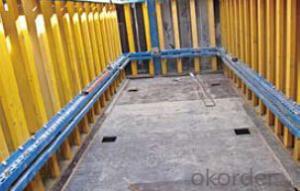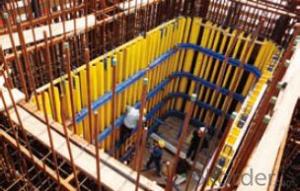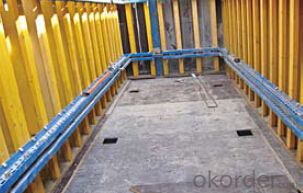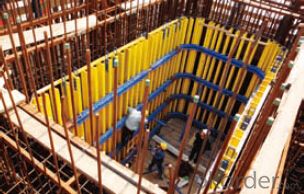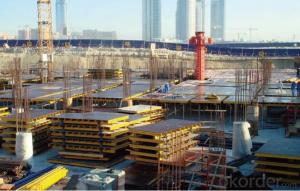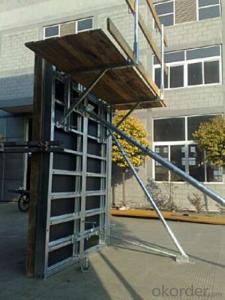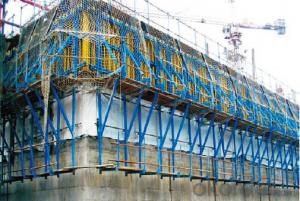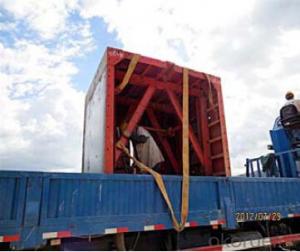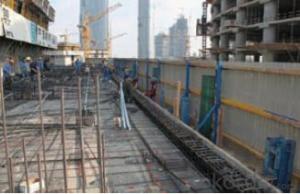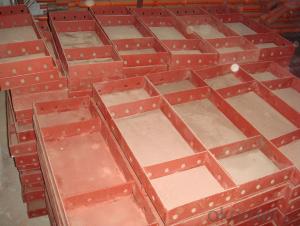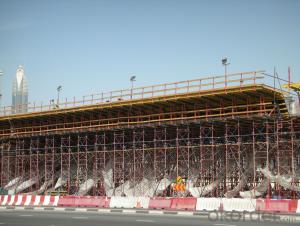Shaft platform S40 Systems for Formwork and Scaffolding
- Loading Port:
- Tianjin
- Payment Terms:
- TT OR LC
- Min Order Qty:
- 50 m²
- Supply Capability:
- 1000 m²/month
OKorder Service Pledge
Quality Product, Order Online Tracking, Timely Delivery
OKorder Financial Service
Credit Rating, Credit Services, Credit Purchasing
You Might Also Like
Shaft Platform
As operating platform, the shaft platform is mainly used in the concrete pouring of elevator shaft,
equipment shaft, stair shaft of high-rise building and so on.
Characteristics:
◆ The length of shaft beam is adjustable.
◆ Flexible structure makes lifting easier.
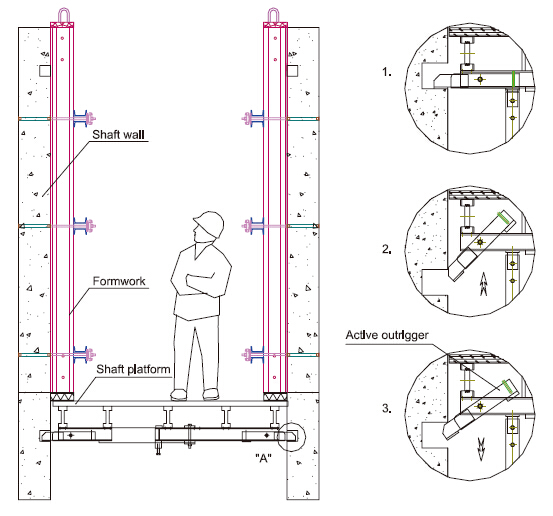
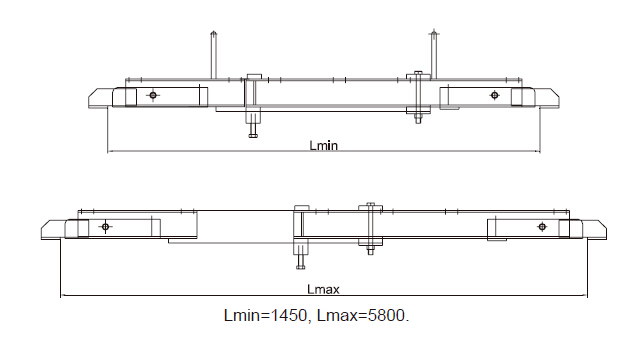
- Q: Can steel formwork be used for structures with high impact resistance requirements?
- Indeed, structures demanding high impact resistance can utilize steel formwork. Renowned for its robustness and durability, steel is ideal for enduring substantial impact loads. Its exceptional strength-to-weight ratio ensures remarkable protection against impact forces. Construction projects necessitating structures capable of withstanding heavy loads or potential impacts, like bridges, tunnels, and tall buildings, regularly employ steel formwork systems. Moreover, steel formwork permits effortless fabrication and assembly, enabling swift and efficient construction of structures with high impact resistance prerequisites.
- Q: How does steel formwork contribute to the construction process?
- Steel formwork is a crucial component in the construction process as it plays a significant role in shaping and supporting concrete structures. It is used for forming walls, columns, beams, and slabs, providing the necessary support during the pouring and curing of concrete. One major contribution of steel formwork is its strength and durability. Steel is known for its high tensile strength, which allows it to withstand the pressure exerted by the weight of the concrete. This strength ensures that the formwork remains intact and stable, preventing any deformation or collapse during the construction process. Additionally, steel formwork is highly versatile and can be customized to any desired shape or size. This flexibility enables architects and engineers to create complex and unique structures that would be difficult to achieve with other formwork materials. The ability to shape the formwork according to specific design requirements ensures that the final concrete structure is not only functional but also aesthetically pleasing. Moreover, steel formwork offers excellent reusability. Unlike other formwork materials such as wood or plywood, steel formwork can be reused multiple times without compromising its structural integrity. This reusability factor not only reduces construction costs but also minimizes waste and promotes sustainability in the construction industry. Another advantage of steel formwork is its ease of assembly and disassembly. It can be quickly installed and dismantled, allowing for faster construction cycles. This efficiency saves time and labor, leading to increased productivity and overall cost savings on construction projects. Furthermore, steel formwork provides a smooth and consistent finish to the concrete surface. The steel panels are designed to be impermeable, preventing any leakage or seepage of concrete. This feature ensures that the concrete cures uniformly, resulting in a high-quality finish that meets the desired specifications. In conclusion, steel formwork significantly contributes to the construction process by providing strength, durability, versatility, reusability, ease of assembly, and a smooth finish to concrete structures. Its essential role in shaping and supporting concrete elements makes it an indispensable tool for modern construction projects.
- Q: How does steel formwork affect construction speed and efficiency?
- Steel formwork can significantly enhance construction speed and efficiency in several ways. Firstly, steel formwork is highly durable and can withstand multiple uses, resulting in reduced time and cost associated with replacing or repairing formwork materials. This allows construction projects to progress smoothly without delays caused by formwork damage or deterioration. Moreover, steel formwork provides a high level of accuracy and precision during the construction process. Its rigid structure ensures consistent dimensions and alignment, resulting in uniformity in concrete placement and reducing the need for adjustments or corrections. This precision saves time and effort, enabling construction teams to work more efficiently and complete projects in a timely manner. Additionally, steel formwork is known for its versatility and adaptability. It can be easily customized to fit various shapes and sizes, allowing for the construction of complex structures with ease. This flexibility eliminates the need for extensive manual cutting or modification of formwork materials, saving time and labor. Furthermore, steel formwork offers a quick assembly and dismantling process. Its modular design allows for easy installation and removal, reducing the time required for formwork preparation and cleanup. This efficiency not only accelerates construction progress but also minimizes downtime between different stages of the project. Lastly, steel formwork is known for its excellent load-bearing capacity. Its sturdy construction can support heavy concrete loads, enabling faster construction cycles by allowing for larger pours and reducing the number of pour breaks. This increases the productivity of the construction team, as they can complete larger sections of the structure in a shorter period. In conclusion, steel formwork positively impacts construction speed and efficiency by providing durability, accuracy, versatility, quick assembly, and load-bearing capabilities. Its contribution to reducing construction time, minimizing errors, and optimizing resource utilization makes it a preferred choice for many construction projects.
- Q: Types of building templates? What is clear water template?
- Wood plywood (water templates): currently widely used in the solid wood plywood formwork, should promote the use of wood covered plywood. Commonly used in Guangdong area of Eucalyptus wood membrane.
- Q: How does steel formwork handle concrete curing?
- Steel formwork is an ideal choice for concrete curing due to its durability and strength. The steel formwork provides a rigid framework, ensuring that the concrete maintains its desired shape and structure during the curing process. Additionally, steel formwork allows for easy demolding once the concrete has cured, saving time and effort.
- Q: Are there any specific design considerations for steel formwork construction?
- Yes, there are several specific design considerations for steel formwork construction. Firstly, the formwork should be designed to withstand the weight of the concrete and the pressure exerted during pouring. It should be structurally strong and rigid to prevent any deformation or collapse. Additionally, the formwork design should allow for easy installation, dismantling, and reusability, as steel formwork is often used in repetitive construction projects. Special attention should be given to the joints and connections to ensure stability and prevent leakage. Finally, proper surface finish and alignment should be considered to achieve the desired concrete finish.
- Q: What are the considerations when designing steel formwork for industrial facilities?
- When designing steel formwork for industrial facilities, several considerations need to be taken into account. Firstly, the load capacity of the formwork must be carefully calculated to ensure it can support the weight of the concrete during pouring and curing. Additionally, the formwork design should allow for ease of installation, dismantling, and reusability to optimize efficiency and cost-effectiveness. The dimensions and shape of the formwork should be tailored to the specific requirements of the industrial facility, considering factors such as floor heights, wall thicknesses, and column sizes. Moreover, the formwork design should incorporate safety measures to protect workers and prevent accidents. Finally, the choice of materials and surface finish should be suitable for the intended applications and environmental conditions, ensuring durability and longevity of the formwork system.
- Q: What are the common design considerations for steel formwork in earthquake-prone areas?
- In earthquake-prone areas, the design considerations for steel formwork are crucial to ensure the safety and stability of structures during seismic events. Some common design considerations for steel formwork in earthquake-prone areas include: 1. Material Strength: The steel used in formwork should have high tensile strength to withstand the lateral forces generated during an earthquake. High-strength steel, such as Grade 60 or Grade 80, is commonly used in earthquake-resistant formwork designs. 2. Reinforcement: The formwork should be adequately reinforced to enhance its rigidity and resistance to seismic forces. Additional reinforcement can be provided by adding steel braces, cross-bracing, or diagonal members to increase the structural integrity of the formwork system. 3. Connection Details: The connection details between different formwork elements should be designed to withstand the dynamic forces induced by earthquakes. Welded or bolted connections are commonly used, ensuring that they have adequate strength and ductility to resist seismic loads. 4. Stiffness and Flexibility: The formwork system should exhibit an appropriate balance between stiffness and flexibility. It should be rigid enough to resist lateral forces during an earthquake but also flexible enough to absorb and dissipate seismic energy without collapsing. 5. Anchorage Systems: Anchorage systems are crucial in securing the formwork to the foundation or supporting structure. These systems should be designed to resist the uplift and lateral forces generated during an earthquake and prevent the formwork from overturning or sliding. 6. Diaphragm Action: To enhance the overall structural performance, the formwork system should be designed to provide diaphragm action. This means that the formwork acts as a continuous and rigid panel transferring forces across its surface, thereby reducing localized stresses and improving the overall stability of the structure during an earthquake. 7. Formwork Compatibility: The steel formwork should be compatible with other structural elements, such as concrete columns, beams, and slabs. It is essential to ensure that the formwork system can adequately transfer the loads from the concrete to the supporting structure without compromising its stability or integrity during seismic events. 8. Construction Practices: In addition to design considerations, proper construction practices play a vital role in ensuring the effectiveness of steel formwork in earthquake-prone areas. Adequate bracing and temporary supports should be used during formwork assembly to maintain stability and prevent collapse before the concrete is poured and hardened. By considering these design considerations, engineers and designers can develop robust steel formwork systems that can withstand the forces exerted by earthquakes and ensure the safety of structures in seismic regions.
- Q: What are the typical lead times for manufacturing steel formwork?
- The typical lead times for manufacturing steel formwork can vary depending on factors such as the complexity of the design, the quantity required, and the current workload of the manufacturer. However, on average, lead times for manufacturing steel formwork can range from a few weeks to a few months.
- Q: What are the factors to consider when selecting steel formwork?
- When selecting steel formwork, there are several important factors to consider. These include the project requirements, such as the size and complexity of the structure, the desired finish, and the required strength and durability. Other factors include the cost-effectiveness of the formwork system, the ease of assembly and disassembly, and the availability and accessibility of the formwork supplier. Additionally, it is crucial to consider the load-bearing capacity and stability of the steel formwork, as well as its compatibility with other construction materials and techniques.
Send your message to us
Shaft platform S40 Systems for Formwork and Scaffolding
- Loading Port:
- Tianjin
- Payment Terms:
- TT OR LC
- Min Order Qty:
- 50 m²
- Supply Capability:
- 1000 m²/month
OKorder Service Pledge
Quality Product, Order Online Tracking, Timely Delivery
OKorder Financial Service
Credit Rating, Credit Services, Credit Purchasing
Similar products
Hot products
Hot Searches
Related keywords
